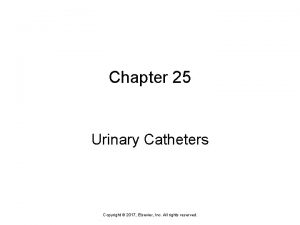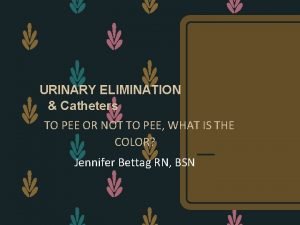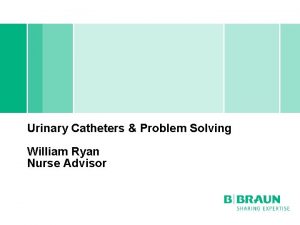Chapter 25 Urinary Catheters Copyright 2017 Elsevier Inc








- Slides: 8

Chapter 25 Urinary Catheters Copyright © 2017, Elsevier, Inc. All rights reserved.

Purposes and Types of Catheters Inserted through the urethra into the bladder, a urinary catheter drains urine into a drainage bag. A straight catheter drains the bladder and then is removed. An indwelling catheter (retention or Foley catheter) is left in the bladder. Ø Catheterization is the process of inserting a catheter. Copyright © 2017, Elsevier, Inc. All rights reserved. 2

Purposes and Types of Catheters (Cont. ) Catheters are used: Ø Ø Ø Ø Before, during, and after surgery For people who are too weak or disabled to use the bedpan, urinal, commode, or toilet To protect wounds and pressure ulcers from contact with urine To allow hourly urinary output measurements As a last resort for incontinence To collect sterile urine specimens For measuring residual urine When caring for persons with indwelling catheters, the risk of infection is high. Copyright © 2017, Elsevier, Inc. All rights reserved. 3

Catheters Urine Drainage systems Ø A closed drainage system is used for indwelling catheters. • Nothing can enter the system from the catheter to the drainage bag. Some people wear leg bags that attach to the thigh or calf when standing up. Ø The drainage bag is always kept lower than the bladder to prevent urinary tract infections (UTIs). Ø Copyright © 2017, Elsevier, Inc. All rights reserved. 4

Catheters (Cont. ) If the drainage system is disconnected accidentally, tell the nurse at once. Ø Ø Ø Do not touch the ends of the catheter or tubing. Practice hand hygiene and put on gloves. Wipe the end of the tube with an antiseptic wipe. Wipe the end of the catheter with another antiseptic wipe. Do not put the ends down. • Do not touch the ends after you clean them. Connect the tubing to the catheter. Ø Discard the wipes into a biohazard bag. Ø Remove the gloves and practice hand hygiene. Ø Copyright © 2017, Elsevier, Inc. All rights reserved. 5

Catheters (Cont. ) Leg bags are changed to drainage bags when the person is in bed. Ø You open the closed drainage system. • Prevents microbes from entering the system. Ø Drainage bags are emptied and urine is measured: • At the end of every shift • When changing from a leg bag to a drainage bag • When changing from a drainage bag to a leg bag • When the bag is becoming full Ø Copyright © 2017, Elsevier, Inc. All rights reserved. 6

Catheters (Cont. ) Removing indwelling catheters Ø An indwelling catheter has two lumens (passageways). • Sterile water is injected through one lumen to inflate the balloon. • Urine drains from the bladder through the other lumen. A physician’s order is needed to remove a catheter. Ø Most people need bladder training first. Ø Dysuria and urinary frequency are common after removing catheters. Ø Copyright © 2017, Elsevier, Inc. All rights reserved. 7

Catheters (Cont. ) Condom catheters (external catheters, Texas catheters, urinary sheaths) are often used for incontinent men. A condom catheter is a soft sheath that slides over the penis. Ø To apply a condom catheter: • Follow the manufacturer’s instructions. • Thoroughly wash the penis with soap and water. • Dry the penis before applying the catheter. Ø Condom catheters are self-adhering or applied with elastic tape. • Never use adhesive tape to secure catheters. Ø Copyright © 2017, Elsevier, Inc. All rights reserved. 8















